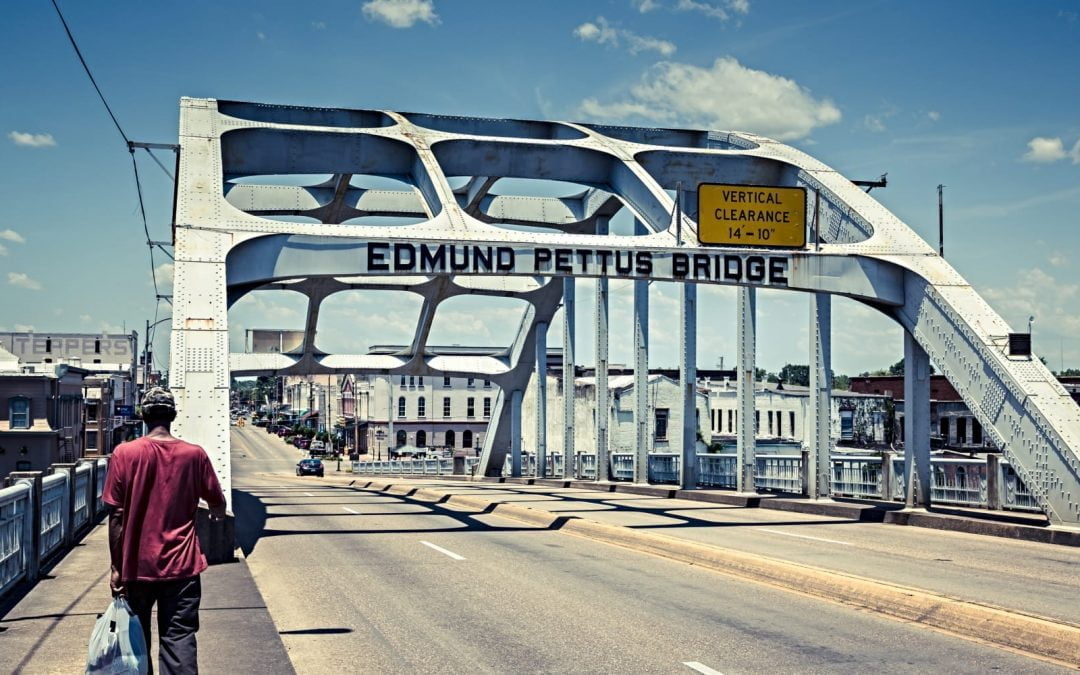A naming controversy over an infamous bridge in Alabama is an appropriate location to reflect upon the polarities that divide us.
America is stretched and pulled by the unavoidable differences arising from our cultural, racial, historical and personal experiences.
We are cut off by our past and the hidden truths we refuse to acknowledge or the shame we are too frightened to confront.
Distance and denial walk happily hand in hand when there’s little motivation to reach across the divide that separates the human family.
In 2015, a petition of 189,000 signatures advanced a Senate bill in the state legislature to rename the Edmund Pettus Bridge.
Built in 1940, this bridge connects Selma to the capital city of Montgomery along Highway 80 and was named for a two-term U.S. senator who entered the race in 1896 at the age of 75 and stayed in office until his death 11 years later.
But it was not for a reputable gentility or seasoned statesmanship his name was meant to be proudly memorialized by the bridge that has made him better known in death than he ever became during his long life.
Historian Wayne Flynt recounts how the purpose of naming places in 1940s Selma was about a black person’s degradation. “It’s a sort of in-your-face reminder of who runs this place.”
The commemorated Pettus was a slave owner, from a family of slave owners who had profited enormously from the cotton industry and the enforced labor that sustained it.
A “true believer,” he fostered a “fanaticism” that moved him up the ranks as a Confederate brigadier general, “legendary” for his tenacious and rebellious spirit.
Never at peace with the defeat of his beloved South or the prejudices and principles that provided the foundations of antebellum society he worked so hard to maintain, he became, after the war, the Grand Dragon of the Alabama Ku Klux Klan.
His leadership in this well-organized structure undoubtedly boosted his successful ascendancy into the U.S. Senate.
Whether or not he was an active participant in the violence of the Klan, it is highly unlikely he would have opposed it.
“I would be very surprised if a man of his social standing actually went out with guns and masks on, but the fact that he knew what was happening is almost inevitable,” Flynt said. “There’s really no way of excluding Edmund Pettus of responsibility from the violence. He helps organize it, he helps protect it, and he does not seek to prosecute anyone who did it.”
Therefore, the recent effort to rename the bridge proposed what sounded like a long overdue change. They suggest the Freedom Bridge would be more fitting, but the movement failed in the Alabama house.
It was challenged, not by those wishing to keep the old ways, but from those wiser witnesses who wanted to ensure the old ways were never forgotten so they would not as likely ever be repeated again.
U.S. House Reps. John Lewis (whose unique voice of authority is underscored by his suffering upon that bridge of infamy) and Terri Sewell are the ones who defended keeping the name of the bridge, arguing that erasing the name would not erase America’s history of racism.
“Renaming the bridge will never erase its history. Instead of hiding our history behind a new name we must embrace it – the good and the bad,” they said.
They are correct. We cannot pretend this past is well behind us.
The tone-deaf response, as noticed by recent (and possibly short-lived) presidential hopeful Howard Schultz, who claimed, “I don’t see color,” ignores the reality of ongoing structural and societal forces that only grow more powerful by our neglect to acknowledge and address them.
We repeat the worst parts of our past when we forget the past and fail to learn from its lessons.
The bridge to our future is an open, frank and honest look at our history. It requires a courageous reach across the racial and economic divide that separates us from our neighbor, and a brutal recounting of one another’s stories, even if we must bear the weight of the pain and shame they are likely to reveal.
Under the name of Pettus, Jim Crow-era abusers sought protection. The name was obscured by troubles and tear gas when the world was shocked to see with their own eyes and on their own tiny black-and-white televisions the freedom fighters attacked and beaten and then courageously and peacefully returning on following days to claim a new destiny.
Today, this name still spells out in honor and dishonor, a place where people of all colors and backgrounds visit, remember and wonder what will lie ahead.
Editor’s note: A version of this article first appeared on Johnson’s website. It is used with permission.
Mark Johnson is senior pastor of Central Baptist Church in Lexington, Kentucky.

